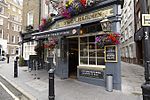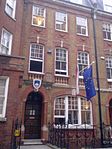Harris Westminster Sixth Form
2014 establishments in EnglandEducation in the City of WestminsterEducational institutions established in 2014Free schools in LondonHarris Federation

Harris Westminster Sixth Form (also known as Harris Westminster or HWSF) is a selective mixed sixth form in central London which was established with the goal of increasing the rate of entry to top universities among students from areas of socio-economic deprivation. Its aim is to "combine the strengths of Westminster School in teaching academically able students with the Harris Federation’s experience in establishing and running outstanding maintained sector schools across London". The Harris Westminster building was bought by the government for £45 million in order to create the school.
Excerpt from the Wikipedia article Harris Westminster Sixth Form (License: CC BY-SA 3.0, Authors, Images).Harris Westminster Sixth Form
Tothill Street, London Millbank
Geographical coordinates (GPS) Address Nearby Places Show on map
Geographical coordinates (GPS)
| Latitude | Longitude |
|---|---|
| N 51.4996 ° | E -0.131 ° |
Address
Harris Westminster Sixth Form
Tothill Street 11
SW1H 9LH London, Millbank
England, United Kingdom
Open on Google Maps








